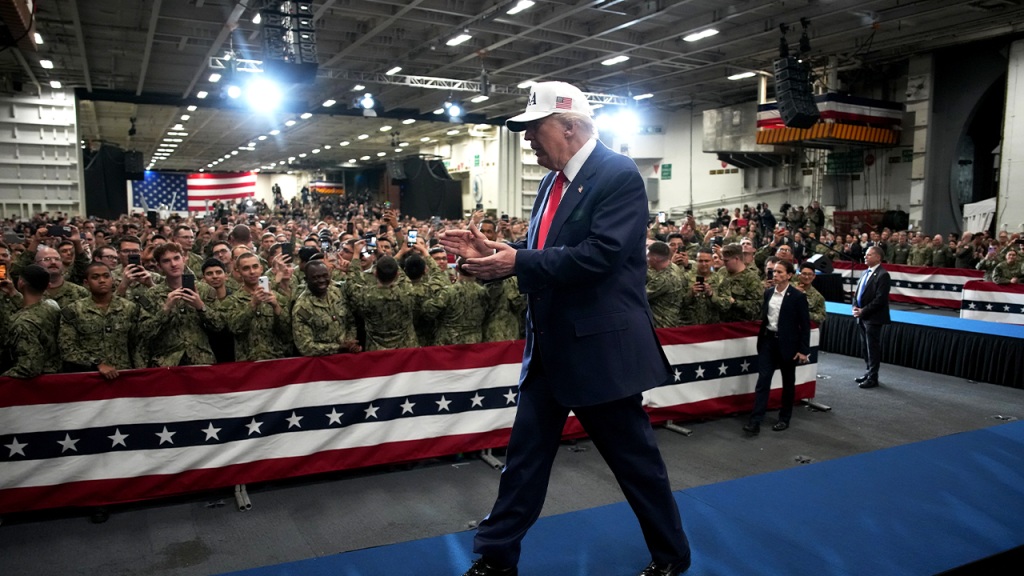Trump’s “Peace Through Strength” Message Resonates in Japan During Asia Tour
President Donald Trump delivered a powerful message to U.S. service members aboard the nuclear-powered aircraft carrier George Washington in Yokosuka, Japan, emphasizing America’s renewed global standing and military prowess. The visit marks a significant moment in Trump’s whirlwind tour through Asia, which includes stops in Malaysia, Japan, and upcoming meetings with Chinese President Xi Jinping in South Korea. Against the backdrop of increasing regional tensions—with China asserting greater control in the South China Sea and North Korea ramping up weapons testing—Trump’s visit underscores the administration’s commitment to projecting American strength on the world stage.
“A year and a half ago, we had a different country than we do right now,” Trump declared to enthusiastic service members who greeted him with chants of “Trump, Trump, Trump.” “Now we’re the most respected country in the world, we’re the hottest country anywhere in the world. And it hasn’t taken too long.” The president wasn’t alone in this significant diplomatic and military showcase; he was joined by Japan’s newly elected Prime Minister Sanae Takaichi—the country’s first female prime minister—and U.S. Secretary of War Pete Hegseth. The joint appearance symbolized the strengthening alliance between the two nations, particularly significant as Japan commits to expanding its defense capabilities. Trump highlighted this collaboration by announcing that “the first batch of missiles for Japan’s Self-Defense Forces will be delivered to the country later this week,” a development that puts the military cooperation “ahead of schedule.”
The president’s address to military personnel reflected his characteristic blend of confidence and directness regarding America’s defense posture. “When it comes to defending the United States, we’re no longer politically correct,” Trump stated firmly. “We’re going to defend our country any way we have to. And that’s usually not the politically correct way. From now on, if we’re in a war, we’re going to win the war. We’re going to win it like nobody ever before.” He also promised tangible benefits for those in uniform, announcing his support for “an across-the-board pay raise for every sailor and service member in the United States armed forces,” a statement met with widespread applause from the assembled troops. Though he acknowledged that Democratic lawmakers would need to approve such a measure, he expressed confidence in eventual bipartisan support despite the ongoing government shutdown that has persisted since October 1.
Prime Minister Takaichi’s participation in the event highlighted Japan’s evolving role in regional security matters. Speaking through a translator, she expressed profound gratitude to both American and Japanese military personnel: “I would like to express my deep respect and sincere gratitude to all the men and women in uniform, from Japan’s Self-Defense Forces and the U.S. forces in Japan, for your dedication and commitment to safeguard peace and security of our nation and the region, day and night.” Her presence aboard the American carrier reflects Japan’s commitment to “fundamentally reinforcing its defense capability” and being “ready to contribute even more proactively to peace and stability in the region.” This aligns with reports that Japan plans to build up its military after years of limiting defense spending to just 1% of GDP, a significant shift in posture for the historically pacifist nation since World War II.
The diplomatic significance of the visit extended beyond military affairs. Trump and Takaichi signed a rare earths framework agreement, a strategic move as the United States looks to reduce its dependence on China for critical minerals essential for modern technology like cell phones. The president characterized the Japanese leader as a “winner,” noting that “their stock market today and our stock market today hit an all-time high. That means we’re doing something right.” He celebrated the remarkable transformation of U.S.-Japan relations since World War II, describing it as “one of the most remarkable relationships in the entire world.” Trump reflected, “Born out of the ashes of a terrible war, our bond has grown over eight decades into the beautiful friendship that we have. It’s a foundation of peace and security in the Pacific.”
As Trump concluded his address, he connected the current service members to America’s proud naval tradition, saying, “Every sailor here today inherits a legacy of valor and grit and glory unmatched in the long history of mankind’s voyage on the seas.” Invoking the spirit of the ship’s namesake, he reminded them of George Washington’s “timeless motto, ‘first in war, first in peace.'” With characteristic confidence, Trump declared that after 250 years, America maintains this position of preeminence: “It’s first in war, first in peace, first in wealth, first in power, first in science, first in spirit and first in freedom.” The president’s Asia tour, which earlier included overseeing a peace agreement between Cambodia and Thailand, continues to focus on trade and regional security matters, culminating in what promises to be a high-stakes summit with Chinese President Xi later this week. Through this diplomatic journey, Trump is projecting a clear message that America has renewed its leadership position on the global stage after what he characterized as “four bad years,” asserting that “now America will always be first.”


